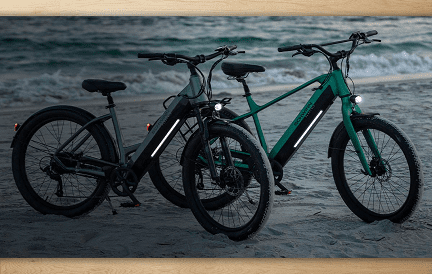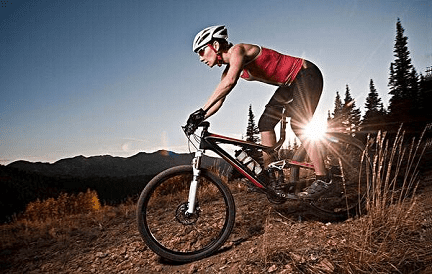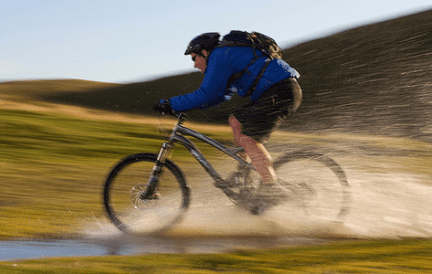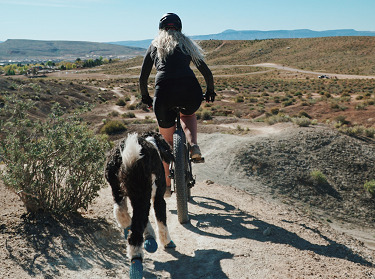One of the advantages of mountain bike single speed conversion is that you can do it cheaply. You could spend a lot, but the basic conversion will start with only one gear and is ideal if you are new to single-speed. We will talk more about it
- Part 1: Several Things About Mountain Bike Riding
- Part 2: Advantages and Disadvantages of Mountain Biking
- Part 3: Benefit and Disadvantages Mountain Bike Single Speed Conversion
- Part 4: How to Convert Your Mountain Bike to Single Speed
- Part 5: Conclusion
Part 1: Several Things About Mountain Bike Riding
Overview of Mountain Bike Riding
Mountain bikes are a great way to exercise while also connecting with nature. When compared to road bikes, mountain bikes are more fun. Deserts, mountains, rocks, and various other terrains are all possibilities. Also, this activity is divided into several categories, including downhill, cross-country, and dirt jumping. Riders must have the necessary tools to fix their broken bicycles. They should also bring a rucksack with valuable items because they will be racing far from civilization.

Mountain Biking Styles
Trail
A trail is a style for you if you want to meet up with your best friend at a local trailhead and ride various peaks and descents. This category of bikes prioritizes pleasure, efficiency, and manageable overall weight.
Cross-country
Fast riding with a focus on climbing prowess is typical of this riding style. Distances range from a few miles to more than 25 miles, and bikes are designed to be light and efficient. If you’re thinking about getting competitive or just want a faster ride on your local trails, these bikes are an excellent option.
Enduro
Consider enduro riding to be trail riding on steroids, with longer, white-knuckle descents and more technical terrain. Bikes intended for all-mountain/enduro riding are light and nimble enough to cycle uphill while also performing well on steep descents.
The name “enduro” derives from the realm of racing and refers to competition, including timed downhill and untimed uphill sections. Whoever has the fastest combined time on the downhills is the winner.
Downhill
This riding is typically done at lift-served bike parks during the warmer months. Surely, you will ride enormous, powerful bikes and protect yourself with full-face helmets and body armor. Also, the bikes have more durable components, fewer gears, and increased travel in the suspension. All of this assists you in overcoming obstacles such as jumps, berms, rock gardens, and wooden ladders. You don’t have to pedal much because you’re on a steady drop the entire time, but you still get a good workout because you’re always reacting to the fast-approaching terrain.
Part 2: Advantages and Disadvantages of Mountain Biking
Advantages
Heart Health Improvements
Cardiovascular fitness can be improved by regular exercise. The British Medical Association analyzed 10,000 participants and found that cycling for at least 20 kilometers a week reduced the risk of coronary heart disease by nearly half. Mountain biking requires a lot of oxygen because it works for substantial muscle groups. Because of that, this encourages your heart to work more consistently, increasing your heart fitness by 3–7%.
Less Stress On The Joints
Mountain biking is a low-impact sport, which means it is easier on the joints than other aerobic exercises like running. Cycling is also a non-load-bearing sport, which means the act of sitting relieves pressure on your joints and lowers your chance of injury.
The Disease is Less Likely to Occur
Moderate exercise regularly is believed to boost your immune system and keep you healthy. According to researchers at the University of North Carolina, people who cycle for 30 minutes 5 days a week take half as many sick days off work as their sedentary counterparts. According to another study published in the European Journal of Epidemiology, women who exercised regularly, including cycling to work, had a lower risk of breast cancer.
Stress is Lessened, and Your Mood is Lifted.
Mountain biking demands cause your body to release natural endorphins, which are the body’s way of feeling good and gaining energy. Exercise also increases your serotonin, a brain molecule that aids in the prevention of depression and anxiety. Also, riding a difficult single-track can become a type of movement meditation. It also lets you relax and weather life’s stresses by diverting your attention away from unpleasant thoughts that contribute to anxiety and despair. Developing new skills and improving your mountain bike abilities also boost your self-esteem and confidence.
Improved Coordination and Balance
Unlike trudging on a treadmill or stair-stepper, Mountain riding is a dynamic activity that regularly challenges the rider to respond to changing terrain, pitch, and height. On a mountain bike, staying steady and secure not only saves you from falling but also improves neural connections and reinforces muscle memory. Furthermore, balance and coordination involve the brain, senses, muscles, and nerve system’s combined efforts.
Disadvantages
Crashing
Falling from a speeding bike could result in a face-smashing or a more serious disaster. As a result, Crashing causes incredible pain.
Regardless of how minor or significant the accident, crashing off would undoubtedly cause you serious agony.
Technical Failure
A good bike may or may not provide you with silky-smooth performance. Even a top of the bike can involve in an accident due to technical failure. Keep in mind that no machine is perfect.
Competition That Isn’t Necessary
People frequently regard the purchase of mountain bikes as a pointless competition. They lose sight of the main reason for purchasing the bike. Also, they get involved in the unhealthy competitiveness of obtaining a mountain bike and frequently abandon the sport.
Maintenance Cost
Extra components and materials are included in full suspension mountain bikes. Furthermore, the extra parts will increase the cost of repair and maintenance. The worst part is that there aren’t many options for a high-quality full suspension mountain bike. As a result, mountain bikes will be expensive to repair, upgrade, or even replace.
Expense
A modern mountain bike can cost up to a thousand dollars, which may be out of reach for many individuals. On the other hand, normal bikes may be less expensive while providing nearly the same benefits.
The higher the manufacturing and consumer costs, the better. The cost of a high-quality full-suspension bike can skyrocket. Also, the full-suspension bike is more expensive than the same model rigid or hardtail bike. So, consider whether you want to go bicycling or whether getting a bike will be a waste of money.
Part 3: Benefit and Disadvantages Mountain Bike Single Speed Conversion
The benefit of mtb single speed conversion:
Easy to Use and Effective
Multi-geared bikes are unquestionably the best way to enhance speed while lowering effort. A derailleur gear is used on all multi-geared models to change the speed and torque of the wheels. Derailleurs, on the other hand, tend to collect much dirt. In addition, frequent speed adjustments may cause them to wear out prematurely.
On the other hand, a single-speed variant has only one gear on the back wheel. This means single-speed, less weight, and less upkeep. Single-speed bikes, In contrast, mountain bikes, do not lose grip on the wheels during speed changes. The motion of the bike is proportional to the pedaling of the rider. Furthermore, the chance of chain derailment is significantly reduced.
Weight Less
Because they lack all of the extra components found on a bike, single-speed bikes are lightweight. As a result, there is no cassette, derailleur, cable, or housing. Single-speed bikes have fewer excess pounds, allowing you to go quicker with less effort. You can also go uphill more efficiently, which reduces the impact on your knees.
Versatile
Single-speed bikes are unquestionably less versatile than multi-geared cycles in terms of speed variation. On the other hand, single-speed bikes allow you to perform things that would be difficult to achieve on a multi-geared bike.
Single-speed bikes, for example, have a single gear transmission system that makes them ideal for training. You can use one of them to travel great distances or move uphill if you want to gain additional leg power.
Furthermore, single-speed bikes feature a freewheel mechanism that allows you to coast or cruise. As a result, if you have sufficient speed, the bike will continue to move even if you stop pedaling. When moving downhill, this function comes in handy because you can use gravity to speed without using your feet.
Simple to Maintain
Single-speed bikes are easier to maintain because fewer components to clean, lubricate, or replace. Furthermore, the features of single-geared bikes are far less expensive than those on multi-speed bikes. Replacing the rear wheel gear, for example, would be a fraction of the expense of replacing a damaged cassette.
In addition, you’ll use fewer materials and spend less time on each maintenance operation. You’ll almost certainly use a lot more grease to lubricate the derailleur and cassette than you would in a single gear.
Affordability
Single-speed bikes are unquestionably cheaper, as they provide you with better control over your bike on any terrain. When going downhill, fixed gear models are also more economical because the pace of descent is independent of the slope, terrain, or gravity. The motion is related to the frequency of pedaling.
There are a few disadvantages that you should be aware of as well.
Going uphill with a single-speed model isn’t always the best option. Using a single gear could result in a significant loss of traction with a rising slope. The more gear you have, the less traction you’ll have.
Using a single gear during a lengthy trip can also leave you weary and cause you to lose your balance. And if you utilize a little gear, you’ll be much more exhausted.
Part 4: How to Convert Your Mountain Bike to Single Speed
Parts you will need
Spacer Kit
Get one with a variety of spacer sizes so you can fine-tune the back cog location for a perfectly straight chain line. Some of the less expensive kits simply come with two spacers, which I do not suggest.
Rear cog
A cheap stamped gear can work if your hub has a steel freehub body (as seen on most lower-end bikes), but if your hub has an aluminum freehub body, you should obtain a special single-speed cog with a more extensive base to avoid scraping the freehub body.
Tensioner
The tensioner keeps the chain in place and prevents it from sliding off. There’s a slim possibility you won’t need it, but it’s a slim chance. Pick one up. You can always return it if it turns out you don’t require it.
Chain
Most single-speed rear gears will not fit 9spd chains. Therefore, either a single speed or an 8spd chain will suffice. If you’re converting an older bike, it might already contain an 8-speed chain, which you can put on your single-speed setup if it’s not too worn.
Note: Several firms sell single-speed conversion kits that contain spacers, cog, and tensioners, making it easier and less expensive to purchase the parts separately.
Tools you will need
Bike conversion requires only basic mechanical knowledge and a few bicycle-specific tools. These are tools that every biker should have because they’re necessary for essential maintenance and part swapping.
- Chain whip and lockring tool
- Chain tool
- Big adjustable wrench.
- Various allen wrenches
Conversion steps
There Will Be No More Shifty Bits
We will not go into too much detail because this is quite basic. Simply take out all of the parts you won’t be using:
-
- chain
- front derailleur
- rear derailleur
- front shifter
- rear shifter
- all shift cables and housing
Alignment and Installation of Rear Cogs
Remove the cassette from the hub and the rear wheel from the frame. Hold the cassette in place with the chain whip, and remove the lock ring with the lockring tool and adjustable wrench. After you’ve released the cassette, it’s time to install the rear cog and align your chain line. Use the spacer kit to line the rear cog with the middle ring on the cranks.
Place the cog and spacers on the wheel where you believe they’ll fit, but don’t overtighten the lockring. Lay the chain across the gear and chainring after putting the wheel into the frame. If you think it is straight, probably it’s not. Remove the back wheel and adjust the cogs and spacers to come closer. Repeat as necessary, and tighten the lockring after you’re satisfied. You won’t get it flawless, but you can go as close as feasible. Straight chains run smoother, wear slower, and are less likely to come off the chainring.
Installing the Chain Length and Tensioner
We’re nearly done! It’s now time to trim the chain to the proper length. Wrap the chain around the middle chainring and rear cog without the tensioner on the bike. Determine where you need to cut the surplus chain. If you want the chain to be as short as possible, then reassemble the remaining chain. The chain is maybe a little too long, resulting in some slack, but the tensioner is for that. If you’re lucky, the gear combination and chainstay length will work out perfectly, and the tensioner will be unnecessary. However, this is a rare occurrence.
It’s easier to install the tensioner if you remove the pulley wheel, so you don’t have to deal with the chain. A spring peg near the derailleur hanger mount on the tensioner should be inserted into the ‘hook’ of the derailleur hanger. The pulley wheel usually is changeable, allowing you to align it with your chain line.
Some tensioners are meant to pull the chain down, while others are designed to pull the chain up. Some tensioners can be used in either direction. Furthermore, a tensioner that pushes up on the chain is preferable because it allows the chain to wrap more tightly around the rear cog, resulting in more teeth engaging the chain and a lower risk of slipping or dropping it. Moreover, a suitable tensioner that presses down on the chain, on the other hand, will suffice.
Part 5: Conclusion
There are numerous advantages to riding a single-speed bike. They help you maintain your fitness, build your muscles, and increase your resistance. Also, when riding downhill, they’re perfect for reaching high speeds. They also let you stop pedaling when you become tired, lowering your chance of a knee injury. So, before you decide to convert your bike to a single-speed, make sure you understand the benefits and drawbacks. It all comes back to you.









